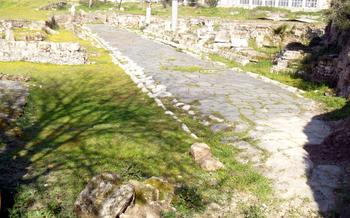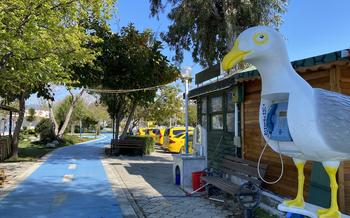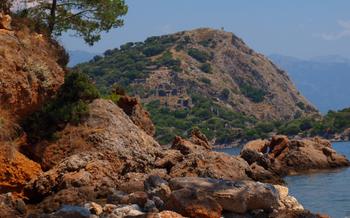
Cleopatra Island (Sedir Island)
- Sun-Kissed Beaches and Crystal-Clear Waters
- Ancient Ruins and Historical Sites
- Exploring the Underwater World
- Indulge in Local Delicacies
- Accommodation and Where to Stay
- Planning Your Visit: Best Time to Go
- Essential Packing List for a Day Trip
- Navigating the Island: A Seamless Journey
- Budgeting for Your Trip: Making the Most of Your Money
- Cultural Etiquette and Customs
- Photography Tips for Capturing Memories
- Insider Tip: Hidden Gems to Discover
Sun-Kissed Beaches and Crystal-Clear Waters
Cleopatra Island's pristine beaches are adorned with soft, golden sand that gently caresses your feet. The crystal-clear waters surrounding the island offer unparalleled visibility, making it a haven for snorkelers and divers. Immerse yourself in the underwater world, where vibrant marine life, colorful coral reefs, and ancient shipwrecks await your discovery.
Bask in the warm embrace of the Mediterranean sun as you laze on the island's sun-kissed shores. Secluded coves and tranquil bays provide idyllic spots for relaxation, where you can unwind amidst the picturesque scenery. Whether you're seeking adventure or serenity, Cleopatra Island's sun-kissed beaches and crystal-clear waters offer an unforgettable experience.
Ancient Ruins and Historical Sites
Cleopatra Island, also known as Sedir Island, boasts a rich historical significance that adds another layer to its allure. The island was once a part of the ancient Greek city of Cedrae, which thrived as a port city during the Hellenistic period. As you explore the island, you'll encounter remnants of this bygone era, including the ruins of a Byzantine basilica, a Roman theater, and various other structures that hint at the island's storied past.
The Byzantine basilica, with its impressive columns and intricate mosaics, offers a glimpse into the island's religious history. The Roman theater, though in ruins, still evokes the grandeur of ancient performances and cultural events. Other ruins scattered throughout the island, such as cisterns, tombs, and fortifications, provide clues to the daily lives and activities of the island's former inhabitants.
To fully appreciate the historical significance of Cleopatra Island, it's recommended to take a guided tour. Knowledgeable guides can provide insights into the history of the island, the significance of the ruins, and the role Cleopatra played in its development. They can also help you navigate the terrain and ensure you don't miss any hidden gems.
Preservation efforts are ongoing to protect and restore the ancient ruins on Cleopatra Island. Visitors are encouraged to respect the historical significance of the site and to avoid damaging or disturbing the ruins in any way. By doing so, we can ensure that future generations can continue to appreciate and learn from this unique historical treasure.
Exploring the Underwater World
Cleopatra Island is a haven for marine enthusiasts, with its crystal-clear waters teeming with a diverse array of marine life. Snorkeling and diving are popular activities that allow visitors to immerse themselves in the underwater wonders of the island. The shallow waters near the shore are ideal for beginners, with excellent visibility and a gentle slope that leads to deeper waters.
For those seeking a more adventurous experience, there are several dive sites around the island that offer encounters with larger marine creatures, such as sea turtles, stingrays, and even dolphins. The underwater terrain is varied, with rock formations, coral reefs, and sandy patches creating a diverse habitat for marine life. Certified divers can explore the deeper waters, where they may encounter ancient shipwrecks and other underwater treasures.
It's important to prioritize safety when engaging in underwater activities. Always check the weather conditions before venturing out, and be mindful of strong currents and tides. Snorkelers and divers should wear appropriate gear, including a wetsuit or drysuit depending on the water temperature, and use a buoyancy compensator device (BCD) to control their depth. It's also advisable to dive with a buddy and be aware of the local regulations and safety guidelines.
Indulge in Local Delicacies
Cleopatra Island is not just a place of historical significance and natural beauty; it's also a culinary haven. The island offers a tantalizing array of local delicacies that will delight your taste buds and leave you craving for more.
One of the must-try dishes on the island is the freshly caught seafood. The crystal-clear waters surrounding Cleopatra Island are home to a variety of fish, including sea bass, bream, and grouper. These are often grilled or fried to perfection and served with a squeeze of lemon and a drizzle of olive oil.
Apart from seafood, the island also offers a range of traditional Turkish dishes that are sure to tantalize your taste buds. Be sure to try the "meze" platters, which feature a selection of small dishes such as hummus, baba ganoush, and stuffed grape leaves.
For those with a sweet tooth, the island offers a variety of traditional Turkish desserts, including baklava, künefe, and Turkish delight. These are often served with a cup of Turkish coffee or tea, providing the perfect end to a delicious meal.
To experience the best of Cleopatra Island's culinary delights, head to one of the many local restaurants or cafes. These establishments often offer stunning views of the island and the surrounding sea, making your dining experience even more memorable.
Here's a tip: Ask the locals for their recommendations on the best places to eat. They'll be happy to share their favorite spots with you.
Accommodation and Where to Stay
Whether you prefer a budget-friendly option or a luxurious retreat, the area surrounding Cleopatra Island offers a diverse range of accommodation to suit every traveler's needs. For those seeking convenience and proximity to the island, opt for hotels or resorts located in the nearby towns of Marmaris or Bodrum. These towns offer a vibrant atmosphere, with a wide selection of hotels ranging from charming guesthouses to upscale resorts. If you prefer a more secluded and tranquil experience, consider staying in smaller villages or towns along the coast, such as Selimiye or Orhaniye. These charming destinations offer a more authentic Turkish experience, with cozy boutique hotels and traditional guesthouses nestled amidst picturesque landscapes.
When choosing your accommodation, consider factors such as your budget, desired amenities, and proximity to the island. For a truly unforgettable experience, opt for a hotel or resort with stunning views of the turquoise waters and lush greenery that surround Cleopatra Island. Many hotels offer private balconies or terraces where you can relax and soak in the breathtaking scenery. To make the most of your stay, consider booking a room with breakfast included, allowing you to start your day with a delicious Turkish breakfast before embarking on your island adventure.
Planning Your Visit: Best Time to Go
When planning your visit to Cleopatra Island, choosing the right time of year is crucial for an optimal experience. The island's Mediterranean climate offers warm and sunny weather for most of the year, making it a popular destination from April to October. However, to fully appreciate the island's natural beauty and avoid the peak tourist season, consider visiting during the shoulder months of May and September.
During these months, the weather is still pleasant, with average temperatures ranging from 18 to 25 degrees Celsius. The crowds are smaller, allowing you to enjoy the island's tranquility and explore its hidden gems without the hustle and bustle of high season. Additionally, the water temperature is still warm enough for swimming, snorkeling, and diving, providing excellent opportunities to explore the island's underwater world.
If you prefer warmer weather, June, July, and August offer the hottest temperatures, with highs reaching up to 30 degrees Celsius. However, keep in mind that these months also attract the most tourists, making it more challenging to find secluded spots and fully immerse yourself in the island's charm.
To avoid the crowds altogether, consider visiting Cleopatra Island in the off-season, from November to March. While the weather may be cooler and wetter, the island takes on a different charm, offering a serene and peaceful retreat. This period is ideal for those seeking solitude, tranquility, and a chance to experience the island's natural beauty without the distractions of the tourist season.
Essential Packing List for a Day Trip
When embarking on a day trip to Cleopatra Island, it's crucial to pack wisely to ensure a comfortable and enjoyable experience. Here's a comprehensive packing list to cover all your needs:
-
Sun Protection: The Mediterranean sun can be intense, so pack a high-SPF sunscreen, a wide-brimmed hat, and sunglasses to protect yourself from harmful UV rays.
-
Swimwear: Bring a comfortable and well-fitting swimsuit or bikini for swimming and enjoying the island's crystal-clear waters.
-
Beach Towel: A large beach towel is essential for drying off after a swim and relaxing on the sandy shores.
-
Comfortable Footwear: Opt for sturdy and comfortable sandals or flip-flops that can withstand walking on various terrains, including sand, pebbles, and rocks.
-
Light Clothing: Pack light and breathable clothing suitable for warm weather, such as shorts, t-shirts, and a light sweater or jacket for cooler evenings.
-
Snacks and Water: While there are limited food options available on the island, it's advisable to bring your own snacks and plenty of water to stay hydrated throughout the day.
-
Camera: Capture the island's stunning beauty with a camera or smartphone. Consider bringing a waterproof camera or housing for underwater photography.
-
Small Backpack or Bag: Carry a small backpack or bag to store your belongings, including sunscreen, snacks, water, and other essentials, while exploring the island.
Navigating the Island: A Seamless Journey
Cleopatra Island is a relatively small island, making it easy to navigate on foot or by bike. The island's layout is straightforward, with well-defined paths and trails leading to the various beaches, historical sites, and other attractions.
For those arriving by boat, the main landing point is located on the western side of the island, near Cleopatra Beach. From here, you can follow the main path that leads inland, passing by the ancient ruins and eventually reaching the eastern shore.
If you're exploring the island on foot, be sure to wear comfortable shoes as the terrain can be uneven in places. Biking is another popular option for getting around, and there are several rental shops on the island where you can hire a bike for the day.
While exploring, keep an eye out for key landmarks such as the ancient theater, the temple of Apollo, and the lighthouse. These sites are well-marked, and there are information boards providing historical context and background.
For those seeking tranquility, there are several secluded spots on the island where you can escape the crowds and enjoy the serene beauty of your surroundings. These hidden gems can be found by venturing off the main paths and exploring the island's lesser-known corners.
Budgeting for Your Trip: Making the Most of Your Money
Planning a trip to Cleopatra Island doesn't have to break the bank. With careful planning and budgeting, you can enjoy an unforgettable experience without overspending. Here's a breakdown of the estimated costs to help you plan your budget:
-
Transportation: Ferry tickets to the island from nearby Marmaris or Bodrum typically range from 10 to 20 euros round trip. If you're coming from a further distance, flights to Dalaman Airport are available, followed by a bus or taxi ride to Marmaris or Bodrum.
-
Accommodation: For budget-conscious travelers, hostels and guesthouses near the island offer dorm beds for around 15-25 euros per night. For a more comfortable stay, mid-range hotels can cost around 50-75 euros per night. Luxury resorts with stunning views can go up to 200 euros or more per night.
-
Food: Enjoying local delicacies doesn't have to be expensive. A typical Turkish breakfast can cost around 5 euros, while a traditional seafood lunch or dinner can range from 10 to 20 euros. Budget around 20-30 euros per day for food, depending on your eating habits.
-
Activities: If you're planning to snorkel or dive, rental equipment can cost around 15-25 euros per day. Boat tours to the island from Marmaris or Bodrum typically start from 30 euros, offering a range of itineraries and experiences.
To save money, consider packing your own snacks and drinks, especially if you're on a day trip. Look for discounts and special offers on accommodation and activities by booking in advance or checking with local tourism offices. Remember, the true beauty of Cleopatra Island lies in its natural wonders, which can be enjoyed without spending a fortune.
Cultural Etiquette and Customs
When visiting Cleopatra Island, respecting local customs and traditions is essential for a harmonious and enjoyable experience. Dress modestly and avoid revealing clothing, especially when exploring the island's religious or historical sites. Be mindful of your behavior in public, and refrain from any actions that may be considered disrespectful or offensive.
When interacting with locals and fellow travelers, a friendly and respectful demeanor is always appreciated. Greet people with a smile and a polite "Merhaba" (hello). Learn a few basic Turkish phrases to show your respect for the local culture. Remember that personal space is valued in Turkish culture, so maintain a comfortable distance during conversations.
If you're unsure about local customs or etiquette, don't hesitate to ask questions or seek guidance from your tour guide or hotel staff. By embracing the local culture and showing respect for its people, you'll create a positive and memorable experience for yourself and those around you.
Photography Tips for Capturing Memories
Cleopatra Island is a photographer's paradise, offering endless opportunities to capture stunning images of its natural beauty and historical charm. To make the most of your photographic adventure, consider the following tips:
-
Camera Settings: Use a wide-angle lens to capture the vastness of the beaches and the surrounding scenery. Adjust your ISO and shutter speed to achieve optimal exposure, especially in bright sunlight. A tripod can help stabilize your camera for sharp and steady shots.
-
Composition: Experiment with different angles and perspectives to create visually interesting compositions. Look for leading lines, such as the pier or the ancient ruins, to draw the viewer's eye into the image.
-
Lighting: The golden hours of sunrise and sunset offer the most flattering light for photography. Plan your visit accordingly to capture the island bathed in a warm, ethereal glow.
-
Underwater Photography: If you're a fan of underwater photography, Cleopatra Island is a great place to capture the vibrant marine life. Use a waterproof camera or housing to protect your equipment and experiment with different underwater settings.
-
Editing: Don't be afraid to edit your photos to enhance their colors, contrast, and overall impact. Use photo editing software to adjust exposure, remove unwanted elements, and create a cohesive look for your album.
Insider Tip: Hidden Gems to Discover
Beyond the popular tourist spots, Cleopatra Island boasts hidden gems waiting to be uncovered. Escape the crowds and venture off the beaten path to discover these enchanting secrets. One such gem is a secluded cove on the island's eastern shore. Accessible only by foot or by boat, this pristine cove offers tranquility and breathtaking views. Spend a day swimming in its crystal-clear waters, sunbathing on its sandy shores, and enjoying a picnic lunch surrounded by nature's beauty.
For history enthusiasts, explore the ruins of an ancient Byzantine church nestled in the island's interior. Discover intricate mosaics, well-preserved frescoes, and remnants of a bygone era. Immerse yourself in the island's rich history as you wander through these ancient ruins, imagining the stories they hold.
For a unique perspective, embark on a kayak or paddleboard adventure around the island. Glide along the coastline, exploring hidden caves, secluded beaches, and stunning rock formations. Take a break to snorkel or dive, discovering the vibrant underwater world teeming with colorful marine life.









